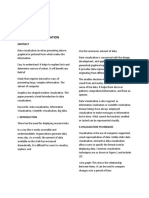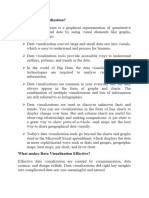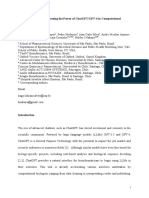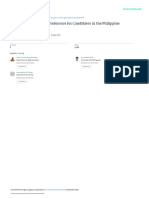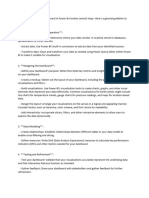Data Visualization and
Preprocessing
Dr. Ashwini Kulkarni,
Department of E&TC,
COEP Technological University
� Importance of data visualization
• Ease and clarity of understanding
• Identifying Patterns and Trends
• Effectively convey the complex information
• Decision-Making made easy
• Analyses massive amount of information and helps take
data driven decision
• Improving Communication
• Powerful tool for storytelling
• Monitoring performance and reporting
• Easy updating and runtime interactivity
• Efficient Communication of Insights
• Increases Data Literacy
� Applications of Data Visualization
• Business and Finance:
– Financial Analysis
– Market Analysis
• Healthcare:
– Patient Data Visualization
– Track and analyze the spread of diseases, facilitating public health responses.
• Marketing and Sales:
– Sales Performance
– Customer Segmentation
• Education:
– Learning Analytics
– Administrative Reporting
• Government and Public Policy:
– Public Sector Reporting
– Policy Analysis
� Applications of Data Visualization
• Technology and IT:
– System Performance Monitoring
– Network Analysis
• Environmental Science:
– Climate Data Analysis
– Geospatial Data Visualization
• Human Resources:
– Workforce Analytics
– Employability Analysis
• Media and Journalism:
– Data-driven Journalism
– Audience Analytics
• Research and Academia:
– Scientific Data Visualization
– Analyzing trends in academic publications and citations.
�Dashboard
� Data types and visualization
techniques
• Quantitative Data:
– Bar Charts: Suitable for comparing quantities or values across different categories.
– Line Charts: Ideal for displaying trends over time or showing relationships between two variables.
– Scatter Plots: Useful for visualizing the relationship between two quantitative variables.
• Categorical Data:
– Pie Charts: Represent the parts of a whole, ideal for displaying the distribution of categories.
– Stacked Bar Charts: Show the composition of a whole across different categories.
– Treemaps: Display hierarchical data using nested rectangles.
• Time Series Data:
– Line Charts: Effective for showing trends, patterns, or changes over a continuous time period.
– Area Charts: Similar to line charts but also show the area beneath the line, useful for visualizing cumulative
quantities over time.
• Hierarchical Data:
– Tree Diagrams: Display hierarchical relationships within a dataset.
– Sunburst Charts: Visualize hierarchical structures with nested rings.
• Geospatial Data:
– Maps: Display data spatially, allowing for the representation of information across regions or locations.
– Choropleth Maps: Use color variations to represent data values in different geographic regions.
� Data types and visualization
techniques
• Correlation and Relationships:
– Scatter Plots: Show the relationship between two variables, helping to identify correlations.
– Bubble Charts: Similar to scatter plots but include an additional dimension represented by the
size of the bubbles.
• Part-to-Whole Relationships:
– Stacked Bar Charts: Display the parts of a whole, with each segment representing a category.
– Treemaps: Visualize hierarchical structures with nested rectangles, representing parts and
sub-parts.
• Distribution of Data:
– Histograms: Represent the distribution of a single quantitative variable.
– Box Plots (Box-and-Whisker Plots): Show the distribution of data and highlight measures like
median and quartiles.
• Comparison of Data Sets:
– Side-by-Side Bar Charts: Compare values of different categories across multiple datasets.
– Grouped Bar Charts: Display grouped data for easy comparison.
• Ranking and Order:
– Bullet Graphs: Display performance against a target, emphasizing ranking and progress.
– Ordered Bar Charts: Arrange bars in a specific order to highlight rankings.
� Need of simultaneous data acquisition
and visualization
• Real-Time Monitoring:
– Industrial Processes: In manufacturing and industrial settings, sensors and devices can continuously collect
data on machinery performance, production rates, and quality metrics. Real-time visualization allows
operators to monitor these parameters and identify issues promptly.
• Financial Trading:
– Stock Market Data: Traders rely on real-time visualizations to monitor stock prices, trading volumes, and
market trends. Timely insights are crucial for making informed investment decisions.
• Healthcare:
– Patient Monitoring: Continuous monitoring of patient data, such as vital signs or telemetry, is vital in
healthcare settings. Real-time visualization helps healthcare professionals respond promptly to any
deviations from normal conditions.
• Environmental Monitoring:
– Weather and Climate Data: Meteorological stations use real-time visualization to display weather patterns,
temperature variations, and other environmental data for accurate forecasting.
• Smart Cities:
– Traffic and Infrastructure Monitoring: Sensors embedded in urban infrastructure can provide real-time data
on traffic flow, parking availability, and energy consumption. Visualization tools help city planners optimize
resource allocation and improve overall efficiency.
�Need of simultaneous data acquisition
and visualization
• Internet of Things (IoT):
– Smart Devices: IoT devices generate a vast amount of data. Simultaneous acquisition and
visualization allow users to monitor and analyze data from various interconnected devices in
real-time.
• Social Media Analytics:
– Social Media Monitoring: Companies and organizations use real-time visualization to track
social media trends, sentiment analysis, and brand mentions. This enables quick responses to
emerging issues or opportunities.
• Network Monitoring:
– IT Infrastructure: Monitoring network performance, security events, and server metrics in
real-time is critical for maintaining the health and security of IT systems.
• Emergency Response:
– Disaster Monitoring: In emergency situations, real-time visualization of data related to
earthquakes, floods, or other disasters helps emergency responders make rapid decisions and
allocate resources efficiently.
• Research and Experiments:
– Scientific Experiments: Researchers often require real-time visualization during experiments
to observe and analyze data as it is generated. This is common in fields such as physics,
chemistry, and biology
� Data Visualisation tools
Online Offline
Infogram.com
Datawrapper Microsoft Word
Pictochart Microsoft Excel
Metachart Microsoft Powerpoint























